Gonorrhoea 2023
Gonorrhea - Annual Report 2023
The national surveillance of gonorrhea at Statens Serum Institut (SSI) is based on data extracted from the Danish Microbiological Database (MiBa). MiBa contains data on test results obtained by both culture and PCR or other nucleic acid amplification techniques (NAAT), as all Departments of Clinical Microbiology (DCMs) in Denmark perform combined NAAT for gonococci and Chlamydia trachomatis.
If repeated positive samples are found in the same person, a new case of gonorrhea is defined as having more than 21 days between positive findings. A negative episode is also defined by 21 days between negative findings. The surveillance of laboratory-confirmed gonorrhea is supplemented with resistance determination of gonococcal isolates submitted to the Department of Bacteria, Parasites & Fungi (BPS), Infectious Preparedness at SSI.
In addition to laboratory-based surveillance, it is mandatory for the treating physician to report all cases of gonorrhea to the Notification System for Infectious Diseases (MIS), Department of Infectious Disease Epidemiology and Prevention (AIF), SSI. Since 2022, this has been done electronically via SEI2. The clinical notification system requests information not included in laboratory data, such as mode of transmission, sexual orientation, country of infection, and HIV status.

In 2023, 5,579 cases of gonorrhea were registered in MiBa across 395,959 episodes, representing a 6% increase in cases and a 3% increase in episodes compared to 2022. The positivity rate remained unchanged at 1.4%, and the proportion of gonorrhea cases reported also remained unchanged from 2022 (77%) to 2023 (75%). The data for 2023 show that the sharp increase seen from 2021 to 2022, EPI-NEWS 50/2023, did not continue into 2023, where only a small increase was observed, Table 1.
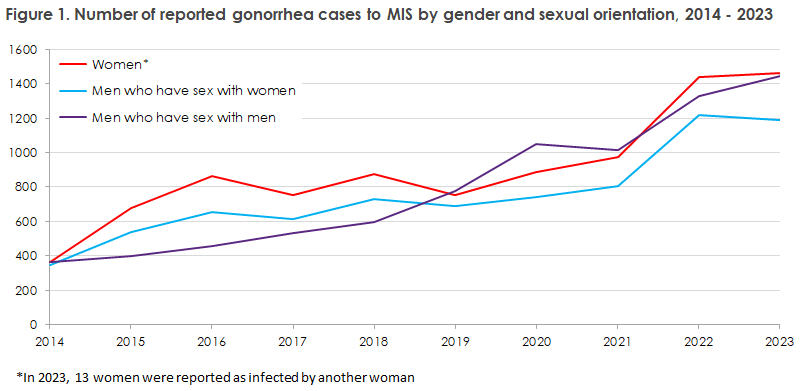
Gender, mode of transmission, origin, and country of infection
The 5,579 cases in 2023 were distributed among 1,935 cases among women and 3,644 among men, resulting in 4,205 reports, which showed that the distribution between men who have sex with men (MSM), men who have sex with women (MSW), and women was largely unchanged from 2022 to 2023, Figure 1.
Thirteen cases were reported as transmission between two women. There were 25 cases among pregnant women diagnosed and reported in 2023. In 2023, 28 sex workers were reported with gonorrhea (21 in 2022). Origin was indicated in 4,192 cases in 2023, of which 74% were born in Denmark and 26% were born abroad. In 2022 and 2023, data on the country of infection were available for 3,987 and 4,176 cases, respectively. In 2023, 8% (6% in 2022) were reported as infected outside Denmark. These 8% also applied to the registered cases of syphilis in Denmark in 2023. A larger proportion of cases among men than among women were reported as infected abroad in both 2022 and 2023. This was 9% of cases among men in both years, while it was 3% and 5% for women, respectively.
Divided by sexual orientation, a larger proportion of cases among men who have sex with men were reported as infected abroad compared to men who have sex with women in both 2022 and 2023 (2022: 11% vs. 6% and 2023: 11% vs. 7%). In 2023, 315 cases were reported as infected abroad. These cases were distributed across 55 countries, with the most cases infected in Spain, Thailand, Germany, France, and the United States.
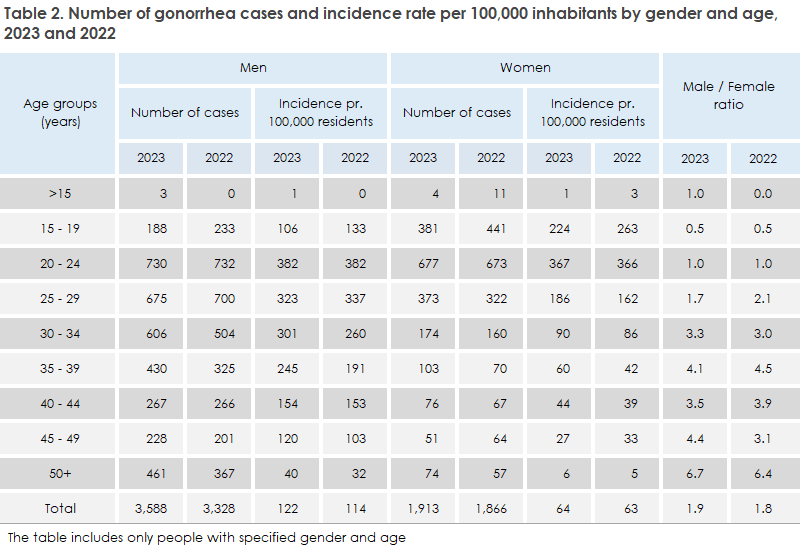
From 2022 to 2023, a small increase was observed among men compared to women. The largest increase among men was seen among 30-39-year-olds and 50+ men, while the largest increase among women was seen among 35-39-year-olds. For both men and women, a significant decrease in the incidence rate was seen among 15-19-year-olds. Men aged 25+ had a significantly higher incidence rate than women in 2023. In 2023, men accounted for 65% of all registered cases, which is on par with 2022 (64%), Table 2.
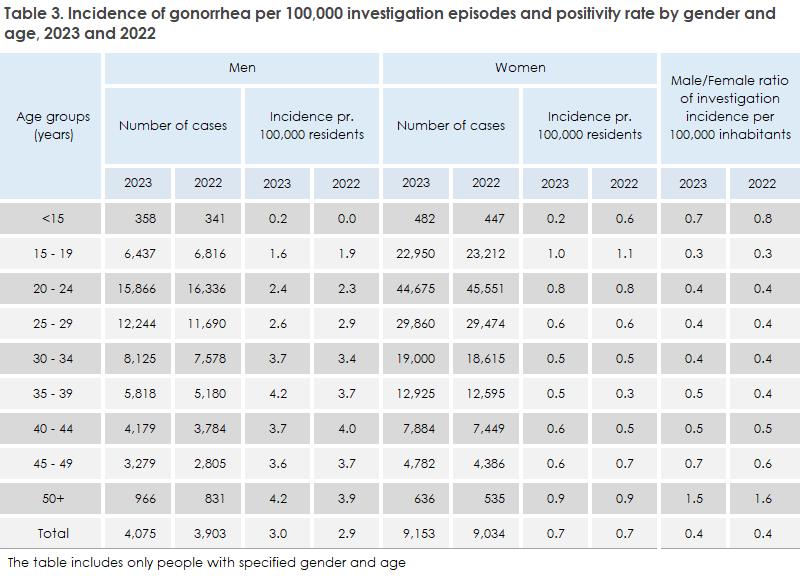
In 2023, more women than men were tested across all age groups except for those aged 50+. The highest incidence of tests per 100,000 inhabitants was among 20-24-year-olds for both genders, 15,866 tests per 100,000 for men and 44,675 tests per 100,000 for women. From 2022 to 2023, the testing incidence for 15-24-year-olds decreased for both genders but increased for all other age groups. No significant changes in the positivity rate were observed across genders and age groups from 2022 to 2023. Men had a significantly higher positivity rate than women in 2023, except for those under 15, where an identical positivity rate was seen for both men and women, Table 3.
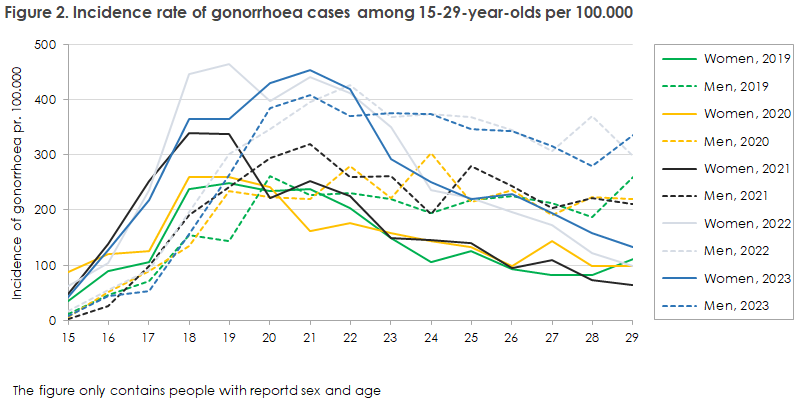
In 2023, a decrease in the incidence rate was seen among young women (17-19-year-olds); otherwise, no significant changes were seen since 2022 for the 15-29 age group, for either men or women, Figure 2.
Gonorrhea Among Children
In 2023, seven cases were registered among individuals under 15 years old (11 in 2022). In both years, a few cases were registered among 0-year-olds in the throat and eyes due to transmission from mother during birth.
Gonorrhea Among Transgender Individuals
In 2023, 21 cases were reported among transgender individuals to MIS, of which ten were trans women and 11 were trans men. This was an increase compared to 2022, where six cases were reported to MIS among transgender individuals. This increase may be due to a general increase among transgender individuals but may also be due to increased awareness among reporting doctors and SSI, and does not necessarily reflect greater risk behavior among transgender individuals.
HIV Among Gonorrhea-Infected Individuals
In 2023, HIV status was reported for 47% of all reported cases, compared to 55% in 2022. Among the 4,205 reported cases in 2023, 4% were among individuals with known HIV and <0.1% among individuals with newly acquired HIV. In 2022, the corresponding figures were 5% and <0.2%, respectively.
As a result of the transition to electronic reporting via SEI2, introduced in 2022, information on the use of PrEP treatment to prevent HIV transmission is available. PrEP treatment is for individuals with risk behavior, such as MSM and transgender individuals. In 2023, 59% of reported gonorrhea cases among HIV-negative MSM were on PrEP treatment. Few women and MSW were reported as being on PrEP treatment in 2023.
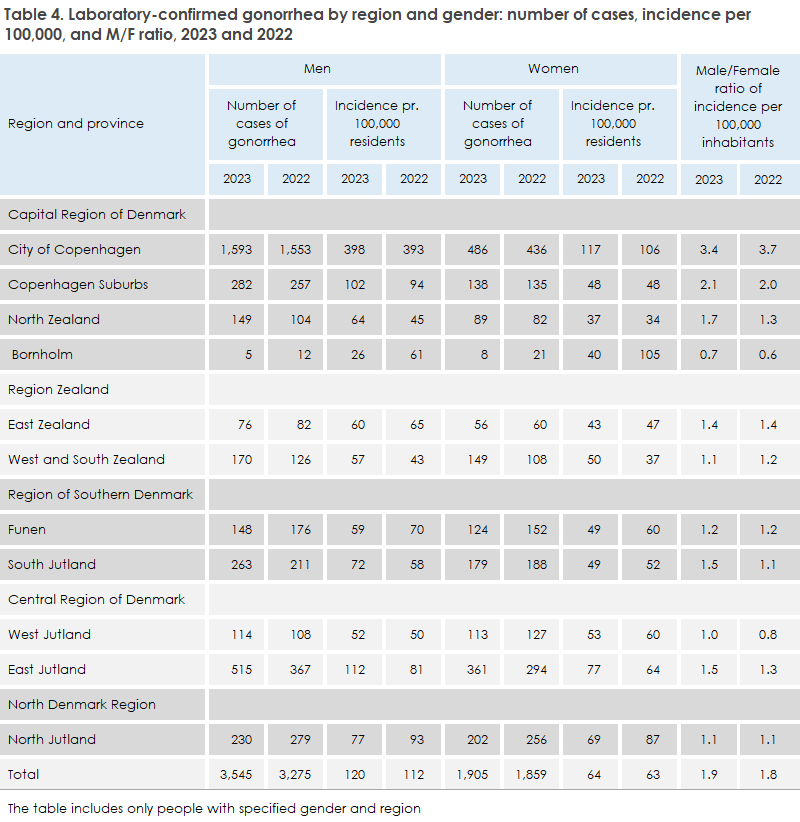
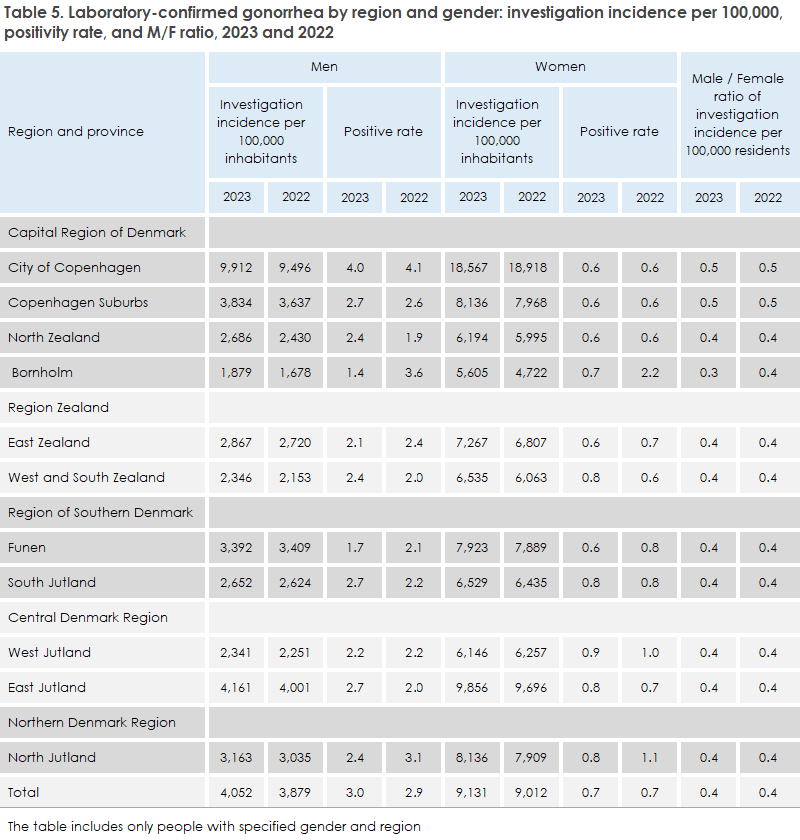
No significant change in the incidence of gonorrhea or positivity rate was observed for either men or women across provinces in Denmark. The largest difference was seen in Bornholm, where both the incidence of registered gonorrhea cases and the positivity rate fell significantly from 2022 to 2023. This decrease may be explained by an atypically high incidence in 2022. Men had a much higher positivity rate in all provinces, highest in Copenhagen City at 4%, where the positivity rate among women was 0.6%. Copenhagen City also had the highest incidence of gonorrhea per 100,000 for both men and women at 398 and 117, respectively. Bornholm was the only province where women had a significantly higher incidence of gonorrhea than men, and in West Jutland, the incidence among men and women was the same. Women were tested significantly more than men across the country, Table 4 and Table 5.
Gonorrhea in Specific Anatomical Locations
In 2023, gonorrhea was detected in 12 cases from the eyes, blood, joint fluid from the wrist and knee, and tissue from fingers, in addition to the usual anatomical sites (urogenital, anorectal, and pharyngeal).
Resistance among Neisseria gonorrhoeae
In 2023, 2,660 N. gonorrhoeae (NG) isolates were distributed across 2,152 episodes and examined at SSI as part of the national resistance surveillance. Isolates with a corresponding report in MIS within 60 days could be assigned a source of infection and sexual orientation, which was the case for 1,740 isolates. NG isolates are tested with MIC (minimum inhibitory concentration) determination at SSI, and EUCAST breakpoints are used to distinguish between resistance and susceptibility. Resistance is tested for azithromycin, ceftriaxone, and ciprofloxacin, as well as penicillinase production. Isolates that are intermediately resistant to ciprofloxacin are treated in this report as resistant.
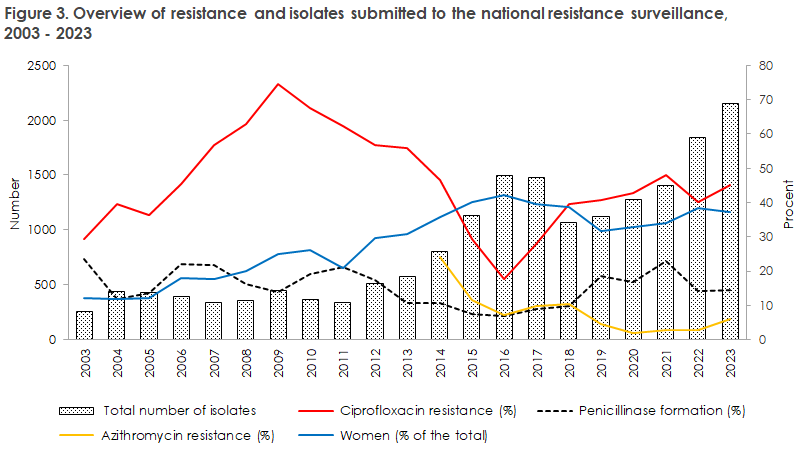
In 2023, a significant increase in the proportion of isolates resistant to azithromycin and a slight increase in resistance to ciprofloxacin were observed. Ceftriaxone resistance has not been recorded in Denmark since 2017. The proportion of penicillinase-producing isolates has remained unchanged since 2022, Figure 3.
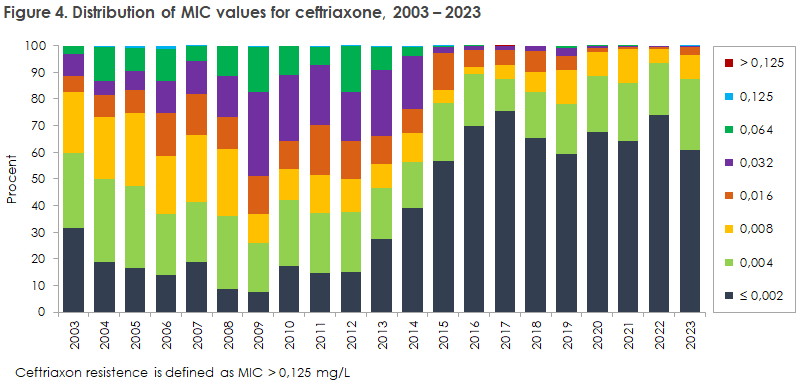
No ceftriaxone resistance was recorded in 2023, and the distribution of MIC values is similar to that in 2022, with a slight increase in the proportion with MIC values in the range of 0.008 – 0.016 mg/L, Figure 4.
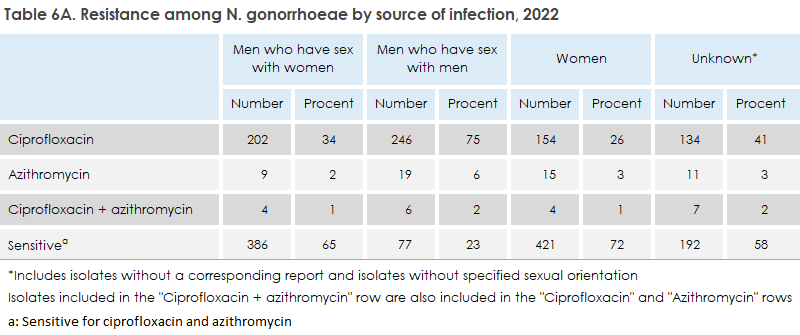
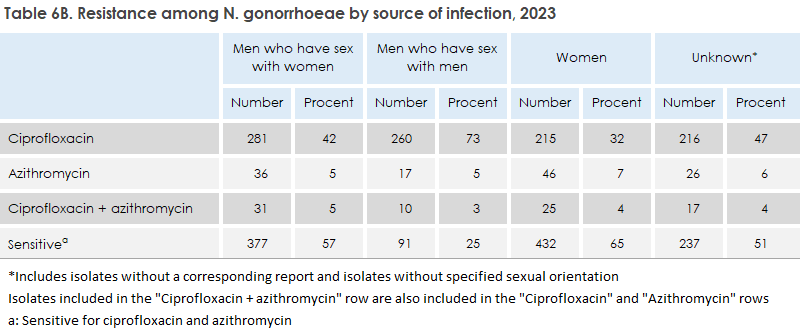
In 2023, the incidence of azithromycin resistance among isolates from women and MSW was significantly higher than in 2022, while it remained unchanged among isolates from MSM, Table 6A and 6B. For both MSW and women, the proportion of NG isolates that were susceptible to both ciprofloxacin and azithromycin decreased, due to the general increase in both ciprofloxacin and azithromycin resistance.
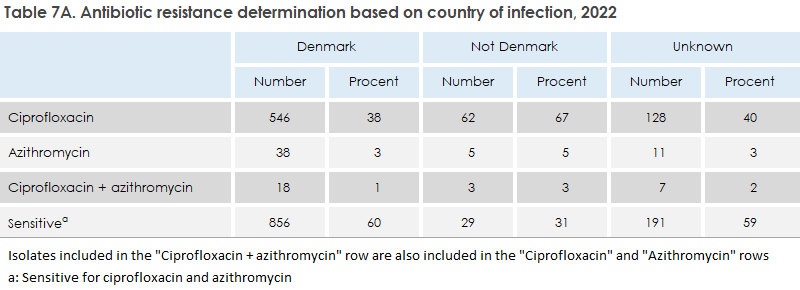
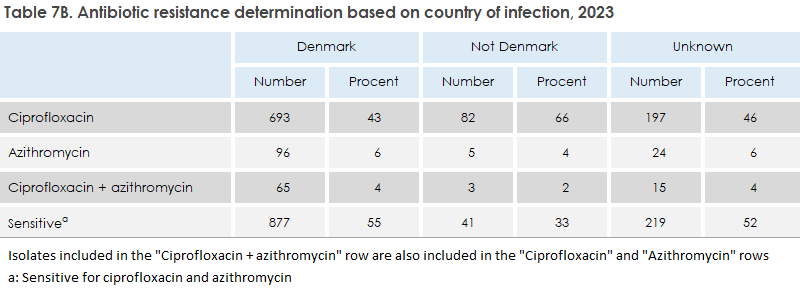
In both 2022 and 2023, a higher prevalence of ciprofloxacin resistance was observed among cases acquired outside Denmark compared to cases acquired in Denmark. However, in 2023, the highest azithromycin resistance rate was observed among cases acquired in Denmark, and the same applied to cases with dual resistance, Table 7A and 7B.
This report is also mentioned in EPI-NYT 49/2024.